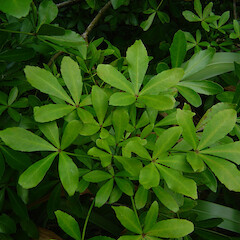Pseudopanax lessonii
Common name
Houpara
Synonyms
Panax lessonii DC.
Family
Araliaceae
Flora category
Vascular – Native
Endemic taxon
Yes
Endemic genus
No
Endemic family
No
Structural class
Trees & Shrubs - Dicotyledons
NVS code
The National Vegetation Survey (NVS) Databank is a physical archive and electronic databank containing records of over 94,000 vegetation survey plots - including data from over 19,000 permanent plots. NVS maintains a standard set of species code abbreviations that correspond to standard scientific plant names from the Ngä Tipu o Aotearoa - New Zealand Plants database.
PSELES
Chromosome number
2n = 48
Current conservation status
The conservation status of all known New Zealand vascular plant taxa at the rank of species and below were reassessed in 2017 using the New Zealand Threat Classification System (NZTCS) – more information about this can be found on the NZTCS website. This report includes a statistical summary and brief notes on changes since 2012 and replaces all previous NZTCS lists for vascular plants.
Please note, threat classifications are often suggested by authors when publications fall between NZTCS assessment periods – an interim threat classification status has not been assessed by the NZTCS panel.
- Conservation status of New Zealand indigenous vascular plants, 2017 . 2018. Peter J. de Lange, Jeremy R. Rolfe, John W. Barkla, Shannel P. Courtney, Paul D. Champion, Leon R. Perrie, Sarah M. Beadel, Kerry A. Ford, Ilse Breitwieser, Ines Schönberger, Rowan Hindmarsh-Walls, Peter B. Heenan and Kate Ladley. Department of Conservation. Source: NZTCS and licensed by DOC for reuse under the Creative Commons Attribution 4.0 International licence.
2017 | Not Threatened
Previous conservation statuses
2012 | Not Threatened
2009 | Not Threatened
2004 | Not Threatened
Brief description
Coastal tree with fleshy hand-shaped leaves
Distribution
Endemic. Three Kings to Poverty Bay and northern Taranaki
Habitat
Coastal forest and scrub
Detailed description
Small tree to 6 m tall; branches stout, with leaves crowded towards tips of branchlets. Leaves alternate, leaflets 3-5, palmate, lateral leaflets smaller; juvenile leaves larger than adult. Petiole to 15 cm long, stout, sheathing stem at base; stipules absent. Leaflets subsessile, terminal leaflet on short petiolule, obovate-cuneate, sinuate-crenate to bluntly serrate in distal half, subacute to obtuse, dark green above, paler beneath, midvein obvious, lateral veins obscure, c. 5-10 x 2-4 cm. Inflorescence a terminal compound umbel; male (staminate) primary rays (branchlets) 4-8 c. 4-5 cm long, flowers racemosely arranged along secondary rays; pistillate (female) primary rays shorter, flowers in irregular umbellules. Petals greenish, acute; anthers on filaments < petals. Ovary 5-loculed, each containing 1 ovule; style branches 5, conate, tips spreading. Fruit fleshy, dark purple, broadly oblong, 7 x 5 mm, style branches retained on an apical disc. 5 Seeds per fruit, narrowly ovate to ovate or oblong, dimpled, 5.5-8.0 mm long.
Similar taxa
Vegetatively similar to Pseudopanax colensoi which has obviously-toothed leaflets
Flower colours
Green
Etymology
pseudopanax: False cure
Attribution
Description adapted from Allan (1961), Eagle (2006) and Webb and Simpson (2001).
References and further reading
Allan, H.H. 1961. Flora of NZ, Vol. I. Government Printer, Wellington
Eagle, A. 2000. Eagle’s complete trees and shrubs of NZ. Te Papa Press, Wellington
Webb, C.J. & Simpson, M.J.A. 2001. Seeds of NZ gymnosperms and dicotyledons. Manuka Press, Christchurch.








